ACC8000 Research in Accounting: Audit, Assurance and Agency Theory
VerifiedAdded on 2023/06/11
|13
|4033
|438
Report
AI Summary
This report provides a comprehensive analysis of accounting, audit, and assurance principles, focusing on compensation packages and agency theory. It addresses questions related to employee motivation, the impact of risk attitude on compensation, and the limitations of performance-based compensation. The report also explores the role of executive compensation committees and the application of agency theory in both profit and non-profit organizations, contrasting it with stakeholder and stewardship theories. Furthermore, it examines an empirical study on audit expectation gaps, detailing the research methodology, participant selection, and data analysis techniques used to identify and understand the factors contributing to these gaps. This document is available on Desklib, a platform offering a wealth of study resources for students.
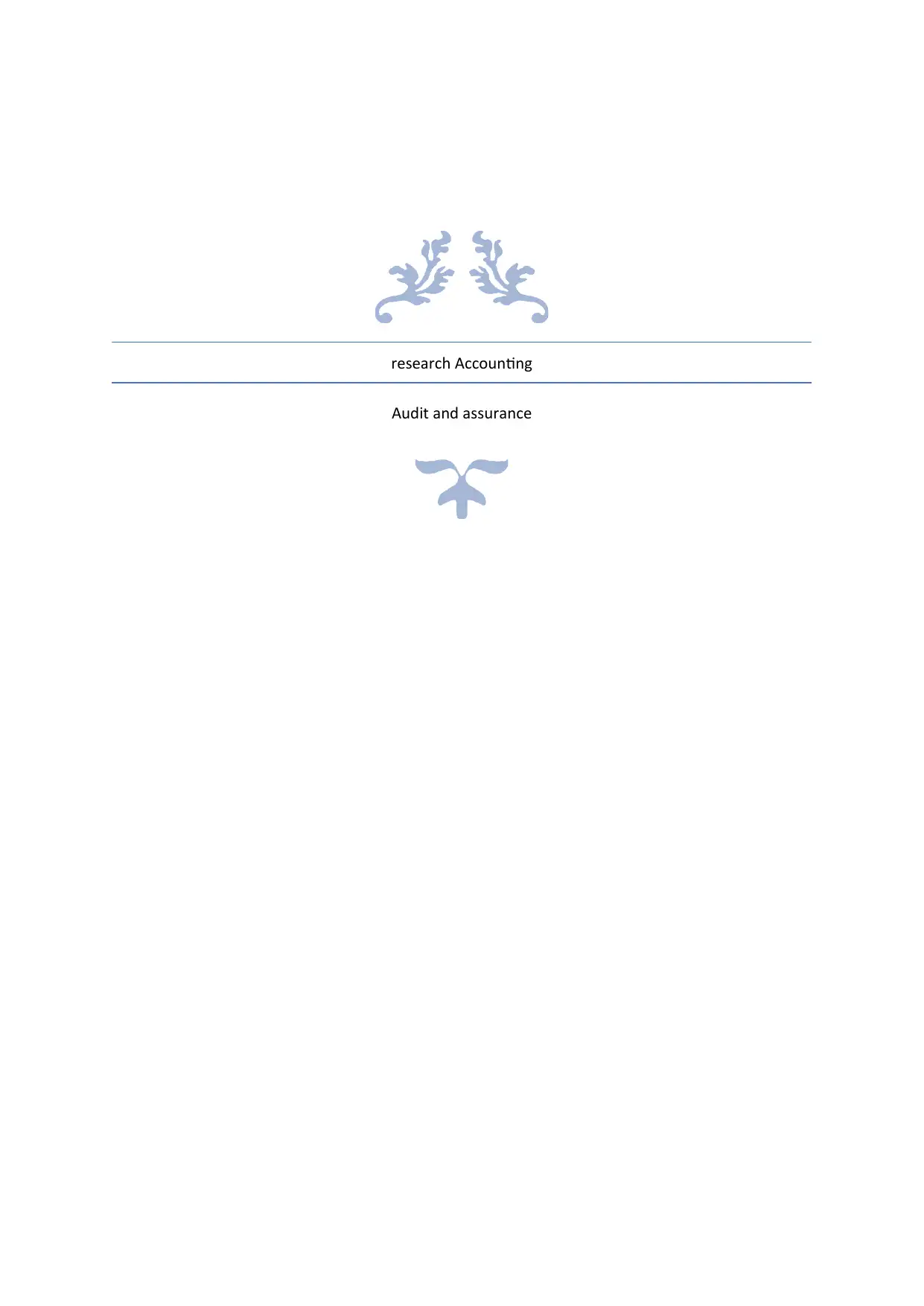
research Accounting
Audit and assurance
Audit and assurance
Paraphrase This Document
Need a fresh take? Get an instant paraphrase of this document with our AI Paraphraser
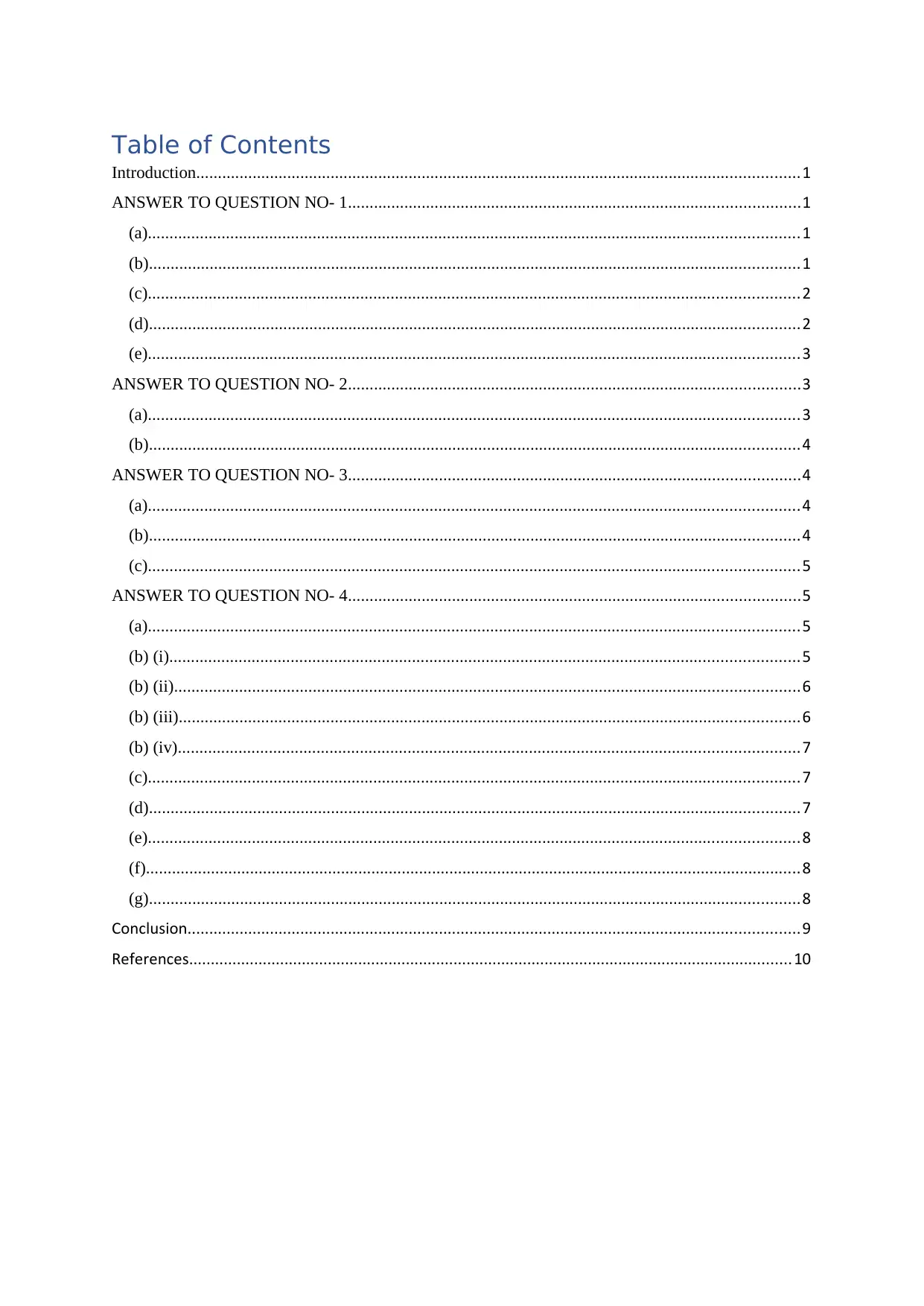
Table of Contents
Introduction...........................................................................................................................................1
ANSWER TO QUESTION NO- 1........................................................................................................1
(a)......................................................................................................................................................1
(b)......................................................................................................................................................1
(c)......................................................................................................................................................2
(d)......................................................................................................................................................2
(e)......................................................................................................................................................3
ANSWER TO QUESTION NO- 2........................................................................................................3
(a)......................................................................................................................................................3
(b)......................................................................................................................................................4
ANSWER TO QUESTION NO- 3........................................................................................................4
(a)......................................................................................................................................................4
(b)......................................................................................................................................................4
(c)......................................................................................................................................................5
ANSWER TO QUESTION NO- 4........................................................................................................5
(a)......................................................................................................................................................5
(b) (i).................................................................................................................................................5
(b) (ii)................................................................................................................................................6
(b) (iii)...............................................................................................................................................6
(b) (iv)...............................................................................................................................................7
(c)......................................................................................................................................................7
(d)......................................................................................................................................................7
(e)......................................................................................................................................................8
(f).......................................................................................................................................................8
(g)......................................................................................................................................................8
Conclusion.............................................................................................................................................9
References...........................................................................................................................................10
Introduction...........................................................................................................................................1
ANSWER TO QUESTION NO- 1........................................................................................................1
(a)......................................................................................................................................................1
(b)......................................................................................................................................................1
(c)......................................................................................................................................................2
(d)......................................................................................................................................................2
(e)......................................................................................................................................................3
ANSWER TO QUESTION NO- 2........................................................................................................3
(a)......................................................................................................................................................3
(b)......................................................................................................................................................4
ANSWER TO QUESTION NO- 3........................................................................................................4
(a)......................................................................................................................................................4
(b)......................................................................................................................................................4
(c)......................................................................................................................................................5
ANSWER TO QUESTION NO- 4........................................................................................................5
(a)......................................................................................................................................................5
(b) (i).................................................................................................................................................5
(b) (ii)................................................................................................................................................6
(b) (iii)...............................................................................................................................................6
(b) (iv)...............................................................................................................................................7
(c)......................................................................................................................................................7
(d)......................................................................................................................................................7
(e)......................................................................................................................................................8
(f).......................................................................................................................................................8
(g)......................................................................................................................................................8
Conclusion.............................................................................................................................................9
References...........................................................................................................................................10
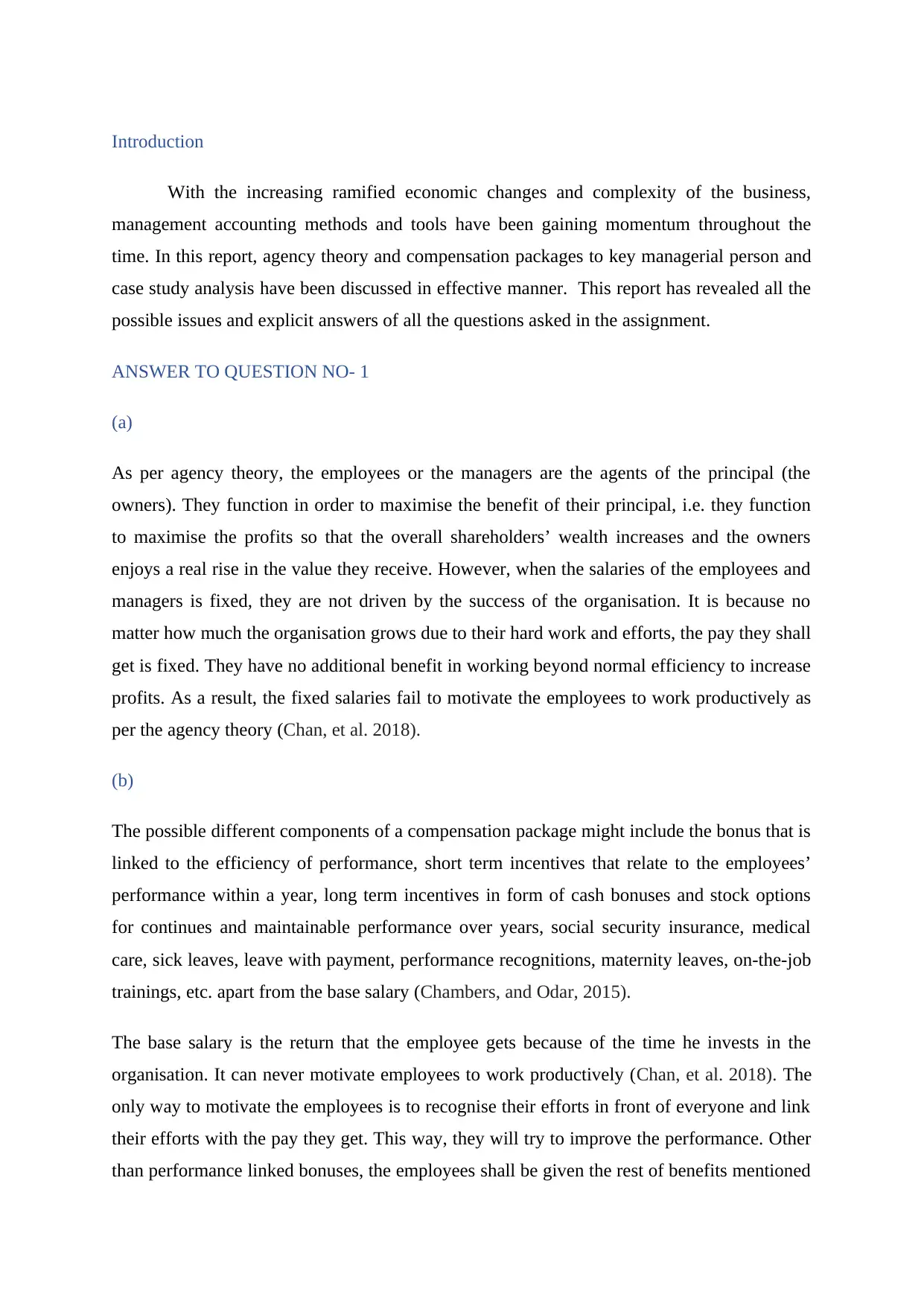
Introduction
With the increasing ramified economic changes and complexity of the business,
management accounting methods and tools have been gaining momentum throughout the
time. In this report, agency theory and compensation packages to key managerial person and
case study analysis have been discussed in effective manner. This report has revealed all the
possible issues and explicit answers of all the questions asked in the assignment.
ANSWER TO QUESTION NO- 1
(a)
As per agency theory, the employees or the managers are the agents of the principal (the
owners). They function in order to maximise the benefit of their principal, i.e. they function
to maximise the profits so that the overall shareholders’ wealth increases and the owners
enjoys a real rise in the value they receive. However, when the salaries of the employees and
managers is fixed, they are not driven by the success of the organisation. It is because no
matter how much the organisation grows due to their hard work and efforts, the pay they shall
get is fixed. They have no additional benefit in working beyond normal efficiency to increase
profits. As a result, the fixed salaries fail to motivate the employees to work productively as
per the agency theory (Chan, et al. 2018).
(b)
The possible different components of a compensation package might include the bonus that is
linked to the efficiency of performance, short term incentives that relate to the employees’
performance within a year, long term incentives in form of cash bonuses and stock options
for continues and maintainable performance over years, social security insurance, medical
care, sick leaves, leave with payment, performance recognitions, maternity leaves, on-the-job
trainings, etc. apart from the base salary (Chambers, and Odar, 2015).
The base salary is the return that the employee gets because of the time he invests in the
organisation. It can never motivate employees to work productively (Chan, et al. 2018). The
only way to motivate the employees is to recognise their efforts in front of everyone and link
their efforts with the pay they get. This way, they will try to improve the performance. Other
than performance linked bonuses, the employees shall be given the rest of benefits mentioned
With the increasing ramified economic changes and complexity of the business,
management accounting methods and tools have been gaining momentum throughout the
time. In this report, agency theory and compensation packages to key managerial person and
case study analysis have been discussed in effective manner. This report has revealed all the
possible issues and explicit answers of all the questions asked in the assignment.
ANSWER TO QUESTION NO- 1
(a)
As per agency theory, the employees or the managers are the agents of the principal (the
owners). They function in order to maximise the benefit of their principal, i.e. they function
to maximise the profits so that the overall shareholders’ wealth increases and the owners
enjoys a real rise in the value they receive. However, when the salaries of the employees and
managers is fixed, they are not driven by the success of the organisation. It is because no
matter how much the organisation grows due to their hard work and efforts, the pay they shall
get is fixed. They have no additional benefit in working beyond normal efficiency to increase
profits. As a result, the fixed salaries fail to motivate the employees to work productively as
per the agency theory (Chan, et al. 2018).
(b)
The possible different components of a compensation package might include the bonus that is
linked to the efficiency of performance, short term incentives that relate to the employees’
performance within a year, long term incentives in form of cash bonuses and stock options
for continues and maintainable performance over years, social security insurance, medical
care, sick leaves, leave with payment, performance recognitions, maternity leaves, on-the-job
trainings, etc. apart from the base salary (Chambers, and Odar, 2015).
The base salary is the return that the employee gets because of the time he invests in the
organisation. It can never motivate employees to work productively (Chan, et al. 2018). The
only way to motivate the employees is to recognise their efforts in front of everyone and link
their efforts with the pay they get. This way, they will try to improve the performance. Other
than performance linked bonuses, the employees shall be given the rest of benefits mentioned
⊘ This is a preview!⊘
Do you want full access?
Subscribe today to unlock all pages.

Trusted by 1+ million students worldwide
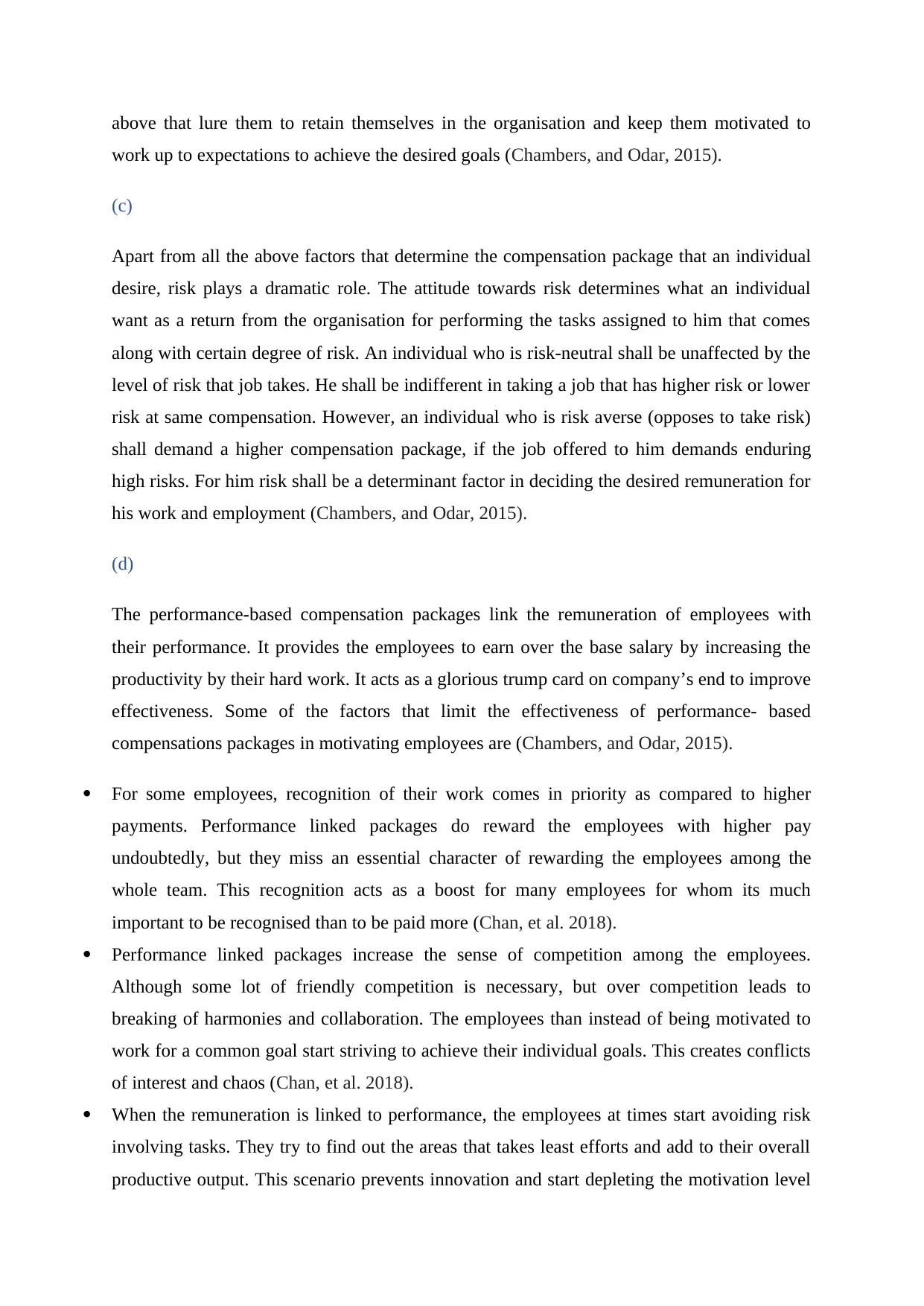
above that lure them to retain themselves in the organisation and keep them motivated to
work up to expectations to achieve the desired goals (Chambers, and Odar, 2015).
(c)
Apart from all the above factors that determine the compensation package that an individual
desire, risk plays a dramatic role. The attitude towards risk determines what an individual
want as a return from the organisation for performing the tasks assigned to him that comes
along with certain degree of risk. An individual who is risk-neutral shall be unaffected by the
level of risk that job takes. He shall be indifferent in taking a job that has higher risk or lower
risk at same compensation. However, an individual who is risk averse (opposes to take risk)
shall demand a higher compensation package, if the job offered to him demands enduring
high risks. For him risk shall be a determinant factor in deciding the desired remuneration for
his work and employment (Chambers, and Odar, 2015).
(d)
The performance-based compensation packages link the remuneration of employees with
their performance. It provides the employees to earn over the base salary by increasing the
productivity by their hard work. It acts as a glorious trump card on company’s end to improve
effectiveness. Some of the factors that limit the effectiveness of performance- based
compensations packages in motivating employees are (Chambers, and Odar, 2015).
For some employees, recognition of their work comes in priority as compared to higher
payments. Performance linked packages do reward the employees with higher pay
undoubtedly, but they miss an essential character of rewarding the employees among the
whole team. This recognition acts as a boost for many employees for whom its much
important to be recognised than to be paid more (Chan, et al. 2018).
Performance linked packages increase the sense of competition among the employees.
Although some lot of friendly competition is necessary, but over competition leads to
breaking of harmonies and collaboration. The employees than instead of being motivated to
work for a common goal start striving to achieve their individual goals. This creates conflicts
of interest and chaos (Chan, et al. 2018).
When the remuneration is linked to performance, the employees at times start avoiding risk
involving tasks. They try to find out the areas that takes least efforts and add to their overall
productive output. This scenario prevents innovation and start depleting the motivation level
work up to expectations to achieve the desired goals (Chambers, and Odar, 2015).
(c)
Apart from all the above factors that determine the compensation package that an individual
desire, risk plays a dramatic role. The attitude towards risk determines what an individual
want as a return from the organisation for performing the tasks assigned to him that comes
along with certain degree of risk. An individual who is risk-neutral shall be unaffected by the
level of risk that job takes. He shall be indifferent in taking a job that has higher risk or lower
risk at same compensation. However, an individual who is risk averse (opposes to take risk)
shall demand a higher compensation package, if the job offered to him demands enduring
high risks. For him risk shall be a determinant factor in deciding the desired remuneration for
his work and employment (Chambers, and Odar, 2015).
(d)
The performance-based compensation packages link the remuneration of employees with
their performance. It provides the employees to earn over the base salary by increasing the
productivity by their hard work. It acts as a glorious trump card on company’s end to improve
effectiveness. Some of the factors that limit the effectiveness of performance- based
compensations packages in motivating employees are (Chambers, and Odar, 2015).
For some employees, recognition of their work comes in priority as compared to higher
payments. Performance linked packages do reward the employees with higher pay
undoubtedly, but they miss an essential character of rewarding the employees among the
whole team. This recognition acts as a boost for many employees for whom its much
important to be recognised than to be paid more (Chan, et al. 2018).
Performance linked packages increase the sense of competition among the employees.
Although some lot of friendly competition is necessary, but over competition leads to
breaking of harmonies and collaboration. The employees than instead of being motivated to
work for a common goal start striving to achieve their individual goals. This creates conflicts
of interest and chaos (Chan, et al. 2018).
When the remuneration is linked to performance, the employees at times start avoiding risk
involving tasks. They try to find out the areas that takes least efforts and add to their overall
productive output. This scenario prevents innovation and start depleting the motivation level
Paraphrase This Document
Need a fresh take? Get an instant paraphrase of this document with our AI Paraphraser
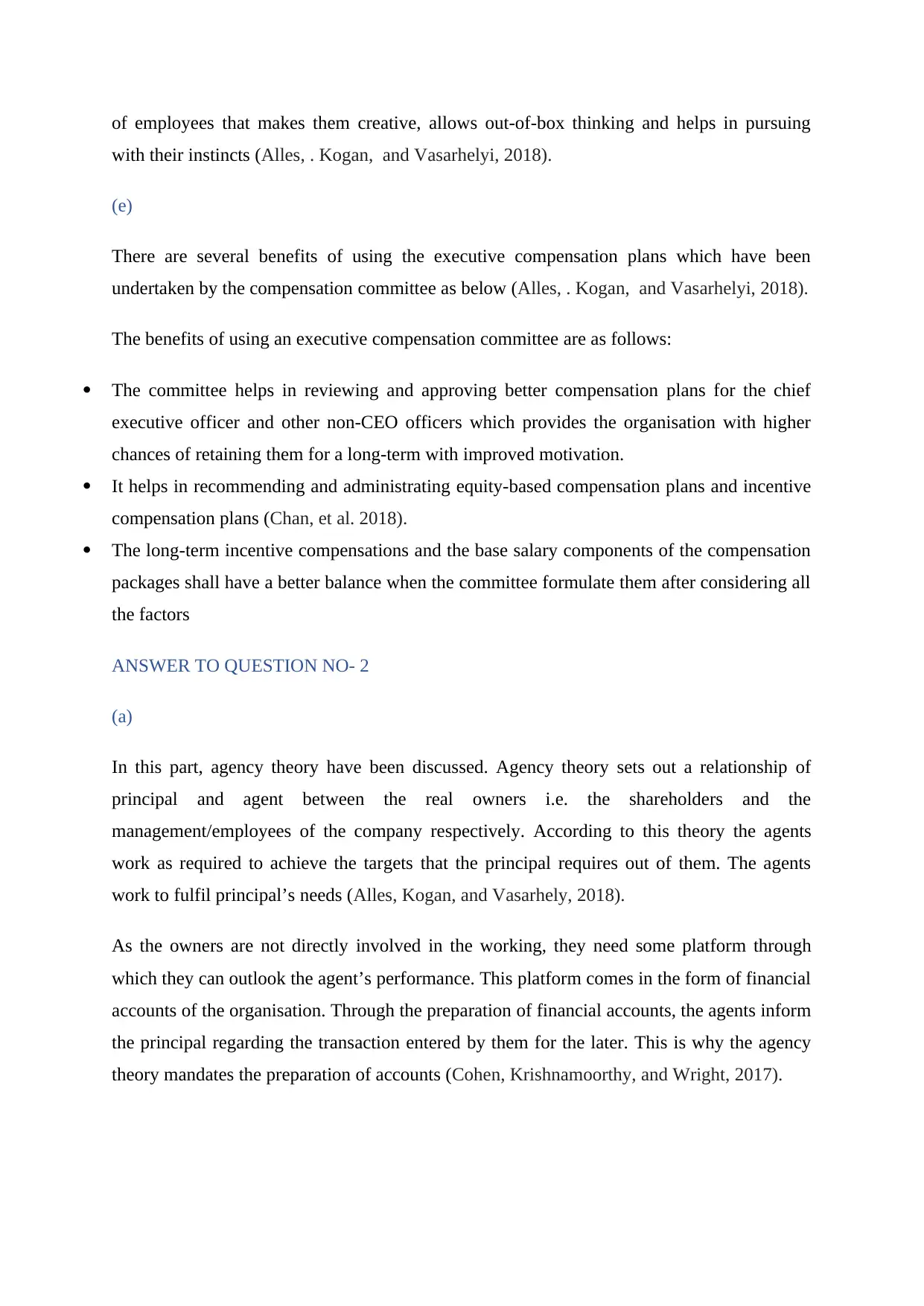
of employees that makes them creative, allows out-of-box thinking and helps in pursuing
with their instincts (Alles, . Kogan, and Vasarhelyi, 2018).
(e)
There are several benefits of using the executive compensation plans which have been
undertaken by the compensation committee as below (Alles, . Kogan, and Vasarhelyi, 2018).
The benefits of using an executive compensation committee are as follows:
The committee helps in reviewing and approving better compensation plans for the chief
executive officer and other non-CEO officers which provides the organisation with higher
chances of retaining them for a long-term with improved motivation.
It helps in recommending and administrating equity-based compensation plans and incentive
compensation plans (Chan, et al. 2018).
The long-term incentive compensations and the base salary components of the compensation
packages shall have a better balance when the committee formulate them after considering all
the factors
ANSWER TO QUESTION NO- 2
(a)
In this part, agency theory have been discussed. Agency theory sets out a relationship of
principal and agent between the real owners i.e. the shareholders and the
management/employees of the company respectively. According to this theory the agents
work as required to achieve the targets that the principal requires out of them. The agents
work to fulfil principal’s needs (Alles, Kogan, and Vasarhely, 2018).
As the owners are not directly involved in the working, they need some platform through
which they can outlook the agent’s performance. This platform comes in the form of financial
accounts of the organisation. Through the preparation of financial accounts, the agents inform
the principal regarding the transaction entered by them for the later. This is why the agency
theory mandates the preparation of accounts (Cohen, Krishnamoorthy, and Wright, 2017).
with their instincts (Alles, . Kogan, and Vasarhelyi, 2018).
(e)
There are several benefits of using the executive compensation plans which have been
undertaken by the compensation committee as below (Alles, . Kogan, and Vasarhelyi, 2018).
The benefits of using an executive compensation committee are as follows:
The committee helps in reviewing and approving better compensation plans for the chief
executive officer and other non-CEO officers which provides the organisation with higher
chances of retaining them for a long-term with improved motivation.
It helps in recommending and administrating equity-based compensation plans and incentive
compensation plans (Chan, et al. 2018).
The long-term incentive compensations and the base salary components of the compensation
packages shall have a better balance when the committee formulate them after considering all
the factors
ANSWER TO QUESTION NO- 2
(a)
In this part, agency theory have been discussed. Agency theory sets out a relationship of
principal and agent between the real owners i.e. the shareholders and the
management/employees of the company respectively. According to this theory the agents
work as required to achieve the targets that the principal requires out of them. The agents
work to fulfil principal’s needs (Alles, Kogan, and Vasarhely, 2018).
As the owners are not directly involved in the working, they need some platform through
which they can outlook the agent’s performance. This platform comes in the form of financial
accounts of the organisation. Through the preparation of financial accounts, the agents inform
the principal regarding the transaction entered by them for the later. This is why the agency
theory mandates the preparation of accounts (Cohen, Krishnamoorthy, and Wright, 2017).
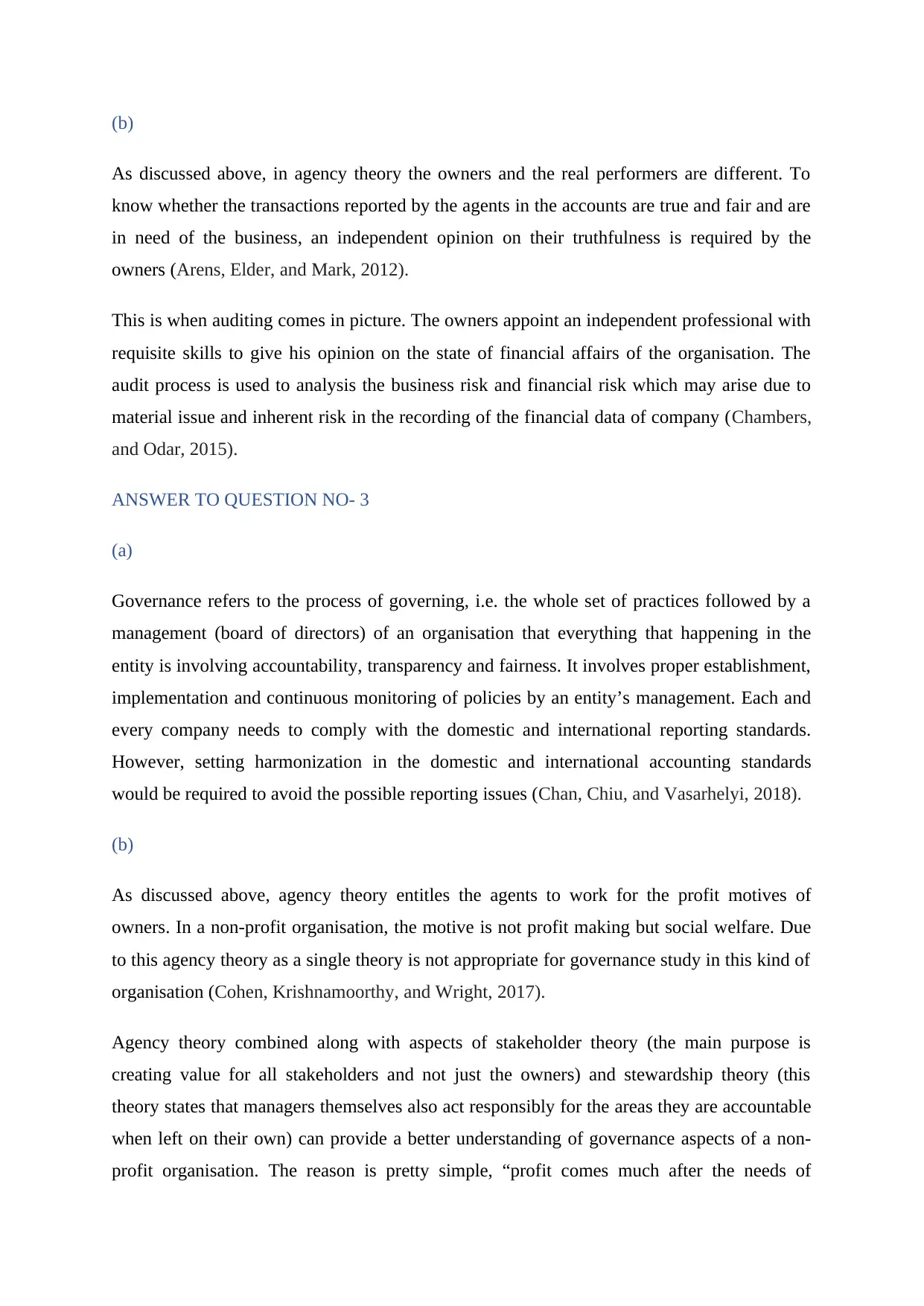
(b)
As discussed above, in agency theory the owners and the real performers are different. To
know whether the transactions reported by the agents in the accounts are true and fair and are
in need of the business, an independent opinion on their truthfulness is required by the
owners (Arens, Elder, and Mark, 2012).
This is when auditing comes in picture. The owners appoint an independent professional with
requisite skills to give his opinion on the state of financial affairs of the organisation. The
audit process is used to analysis the business risk and financial risk which may arise due to
material issue and inherent risk in the recording of the financial data of company (Chambers,
and Odar, 2015).
ANSWER TO QUESTION NO- 3
(a)
Governance refers to the process of governing, i.e. the whole set of practices followed by a
management (board of directors) of an organisation that everything that happening in the
entity is involving accountability, transparency and fairness. It involves proper establishment,
implementation and continuous monitoring of policies by an entity’s management. Each and
every company needs to comply with the domestic and international reporting standards.
However, setting harmonization in the domestic and international accounting standards
would be required to avoid the possible reporting issues (Chan, Chiu, and Vasarhelyi, 2018).
(b)
As discussed above, agency theory entitles the agents to work for the profit motives of
owners. In a non-profit organisation, the motive is not profit making but social welfare. Due
to this agency theory as a single theory is not appropriate for governance study in this kind of
organisation (Cohen, Krishnamoorthy, and Wright, 2017).
Agency theory combined along with aspects of stakeholder theory (the main purpose is
creating value for all stakeholders and not just the owners) and stewardship theory (this
theory states that managers themselves also act responsibly for the areas they are accountable
when left on their own) can provide a better understanding of governance aspects of a non-
profit organisation. The reason is pretty simple, “profit comes much after the needs of
As discussed above, in agency theory the owners and the real performers are different. To
know whether the transactions reported by the agents in the accounts are true and fair and are
in need of the business, an independent opinion on their truthfulness is required by the
owners (Arens, Elder, and Mark, 2012).
This is when auditing comes in picture. The owners appoint an independent professional with
requisite skills to give his opinion on the state of financial affairs of the organisation. The
audit process is used to analysis the business risk and financial risk which may arise due to
material issue and inherent risk in the recording of the financial data of company (Chambers,
and Odar, 2015).
ANSWER TO QUESTION NO- 3
(a)
Governance refers to the process of governing, i.e. the whole set of practices followed by a
management (board of directors) of an organisation that everything that happening in the
entity is involving accountability, transparency and fairness. It involves proper establishment,
implementation and continuous monitoring of policies by an entity’s management. Each and
every company needs to comply with the domestic and international reporting standards.
However, setting harmonization in the domestic and international accounting standards
would be required to avoid the possible reporting issues (Chan, Chiu, and Vasarhelyi, 2018).
(b)
As discussed above, agency theory entitles the agents to work for the profit motives of
owners. In a non-profit organisation, the motive is not profit making but social welfare. Due
to this agency theory as a single theory is not appropriate for governance study in this kind of
organisation (Cohen, Krishnamoorthy, and Wright, 2017).
Agency theory combined along with aspects of stakeholder theory (the main purpose is
creating value for all stakeholders and not just the owners) and stewardship theory (this
theory states that managers themselves also act responsibly for the areas they are accountable
when left on their own) can provide a better understanding of governance aspects of a non-
profit organisation. The reason is pretty simple, “profit comes much after the needs of
⊘ This is a preview!⊘
Do you want full access?
Subscribe today to unlock all pages.

Trusted by 1+ million students worldwide
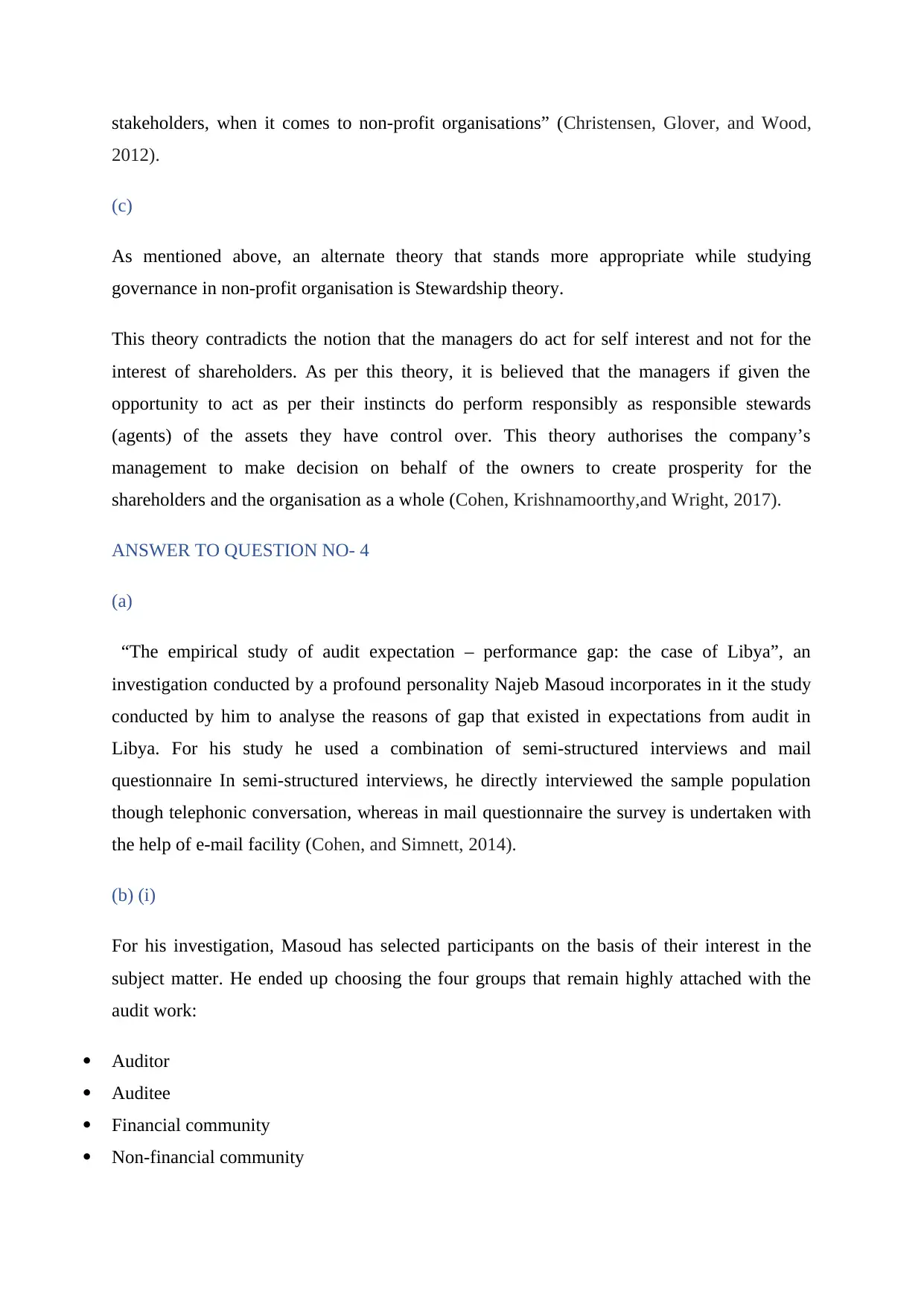
stakeholders, when it comes to non-profit organisations” (Christensen, Glover, and Wood,
2012).
(c)
As mentioned above, an alternate theory that stands more appropriate while studying
governance in non-profit organisation is Stewardship theory.
This theory contradicts the notion that the managers do act for self interest and not for the
interest of shareholders. As per this theory, it is believed that the managers if given the
opportunity to act as per their instincts do perform responsibly as responsible stewards
(agents) of the assets they have control over. This theory authorises the company’s
management to make decision on behalf of the owners to create prosperity for the
shareholders and the organisation as a whole (Cohen, Krishnamoorthy,and Wright, 2017).
ANSWER TO QUESTION NO- 4
(a)
“The empirical study of audit expectation – performance gap: the case of Libya”, an
investigation conducted by a profound personality Najeb Masoud incorporates in it the study
conducted by him to analyse the reasons of gap that existed in expectations from audit in
Libya. For his study he used a combination of semi-structured interviews and mail
questionnaire In semi-structured interviews, he directly interviewed the sample population
though telephonic conversation, whereas in mail questionnaire the survey is undertaken with
the help of e-mail facility (Cohen, and Simnett, 2014).
(b) (i)
For his investigation, Masoud has selected participants on the basis of their interest in the
subject matter. He ended up choosing the four groups that remain highly attached with the
audit work:
Auditor
Auditee
Financial community
Non-financial community
2012).
(c)
As mentioned above, an alternate theory that stands more appropriate while studying
governance in non-profit organisation is Stewardship theory.
This theory contradicts the notion that the managers do act for self interest and not for the
interest of shareholders. As per this theory, it is believed that the managers if given the
opportunity to act as per their instincts do perform responsibly as responsible stewards
(agents) of the assets they have control over. This theory authorises the company’s
management to make decision on behalf of the owners to create prosperity for the
shareholders and the organisation as a whole (Cohen, Krishnamoorthy,and Wright, 2017).
ANSWER TO QUESTION NO- 4
(a)
“The empirical study of audit expectation – performance gap: the case of Libya”, an
investigation conducted by a profound personality Najeb Masoud incorporates in it the study
conducted by him to analyse the reasons of gap that existed in expectations from audit in
Libya. For his study he used a combination of semi-structured interviews and mail
questionnaire In semi-structured interviews, he directly interviewed the sample population
though telephonic conversation, whereas in mail questionnaire the survey is undertaken with
the help of e-mail facility (Cohen, and Simnett, 2014).
(b) (i)
For his investigation, Masoud has selected participants on the basis of their interest in the
subject matter. He ended up choosing the four groups that remain highly attached with the
audit work:
Auditor
Auditee
Financial community
Non-financial community
Paraphrase This Document
Need a fresh take? Get an instant paraphrase of this document with our AI Paraphraser
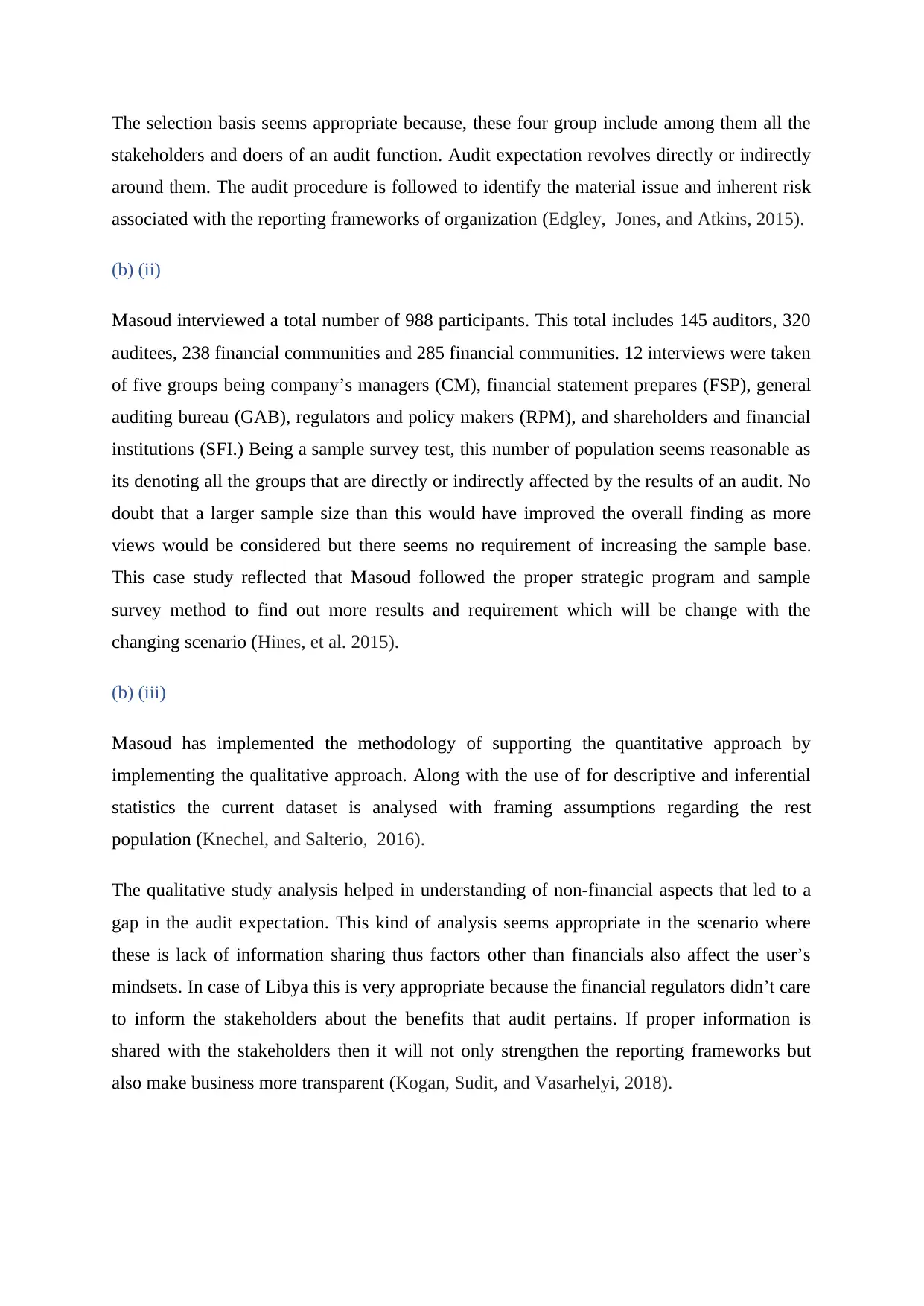
The selection basis seems appropriate because, these four group include among them all the
stakeholders and doers of an audit function. Audit expectation revolves directly or indirectly
around them. The audit procedure is followed to identify the material issue and inherent risk
associated with the reporting frameworks of organization (Edgley, Jones, and Atkins, 2015).
(b) (ii)
Masoud interviewed a total number of 988 participants. This total includes 145 auditors, 320
auditees, 238 financial communities and 285 financial communities. 12 interviews were taken
of five groups being company’s managers (CM), financial statement prepares (FSP), general
auditing bureau (GAB), regulators and policy makers (RPM), and shareholders and financial
institutions (SFI.) Being a sample survey test, this number of population seems reasonable as
its denoting all the groups that are directly or indirectly affected by the results of an audit. No
doubt that a larger sample size than this would have improved the overall finding as more
views would be considered but there seems no requirement of increasing the sample base.
This case study reflected that Masoud followed the proper strategic program and sample
survey method to find out more results and requirement which will be change with the
changing scenario (Hines, et al. 2015).
(b) (iii)
Masoud has implemented the methodology of supporting the quantitative approach by
implementing the qualitative approach. Along with the use of for descriptive and inferential
statistics the current dataset is analysed with framing assumptions regarding the rest
population (Knechel, and Salterio, 2016).
The qualitative study analysis helped in understanding of non-financial aspects that led to a
gap in the audit expectation. This kind of analysis seems appropriate in the scenario where
these is lack of information sharing thus factors other than financials also affect the user’s
mindsets. In case of Libya this is very appropriate because the financial regulators didn’t care
to inform the stakeholders about the benefits that audit pertains. If proper information is
shared with the stakeholders then it will not only strengthen the reporting frameworks but
also make business more transparent (Kogan, Sudit, and Vasarhelyi, 2018).
stakeholders and doers of an audit function. Audit expectation revolves directly or indirectly
around them. The audit procedure is followed to identify the material issue and inherent risk
associated with the reporting frameworks of organization (Edgley, Jones, and Atkins, 2015).
(b) (ii)
Masoud interviewed a total number of 988 participants. This total includes 145 auditors, 320
auditees, 238 financial communities and 285 financial communities. 12 interviews were taken
of five groups being company’s managers (CM), financial statement prepares (FSP), general
auditing bureau (GAB), regulators and policy makers (RPM), and shareholders and financial
institutions (SFI.) Being a sample survey test, this number of population seems reasonable as
its denoting all the groups that are directly or indirectly affected by the results of an audit. No
doubt that a larger sample size than this would have improved the overall finding as more
views would be considered but there seems no requirement of increasing the sample base.
This case study reflected that Masoud followed the proper strategic program and sample
survey method to find out more results and requirement which will be change with the
changing scenario (Hines, et al. 2015).
(b) (iii)
Masoud has implemented the methodology of supporting the quantitative approach by
implementing the qualitative approach. Along with the use of for descriptive and inferential
statistics the current dataset is analysed with framing assumptions regarding the rest
population (Knechel, and Salterio, 2016).
The qualitative study analysis helped in understanding of non-financial aspects that led to a
gap in the audit expectation. This kind of analysis seems appropriate in the scenario where
these is lack of information sharing thus factors other than financials also affect the user’s
mindsets. In case of Libya this is very appropriate because the financial regulators didn’t care
to inform the stakeholders about the benefits that audit pertains. If proper information is
shared with the stakeholders then it will not only strengthen the reporting frameworks but
also make business more transparent (Kogan, Sudit, and Vasarhelyi, 2018).
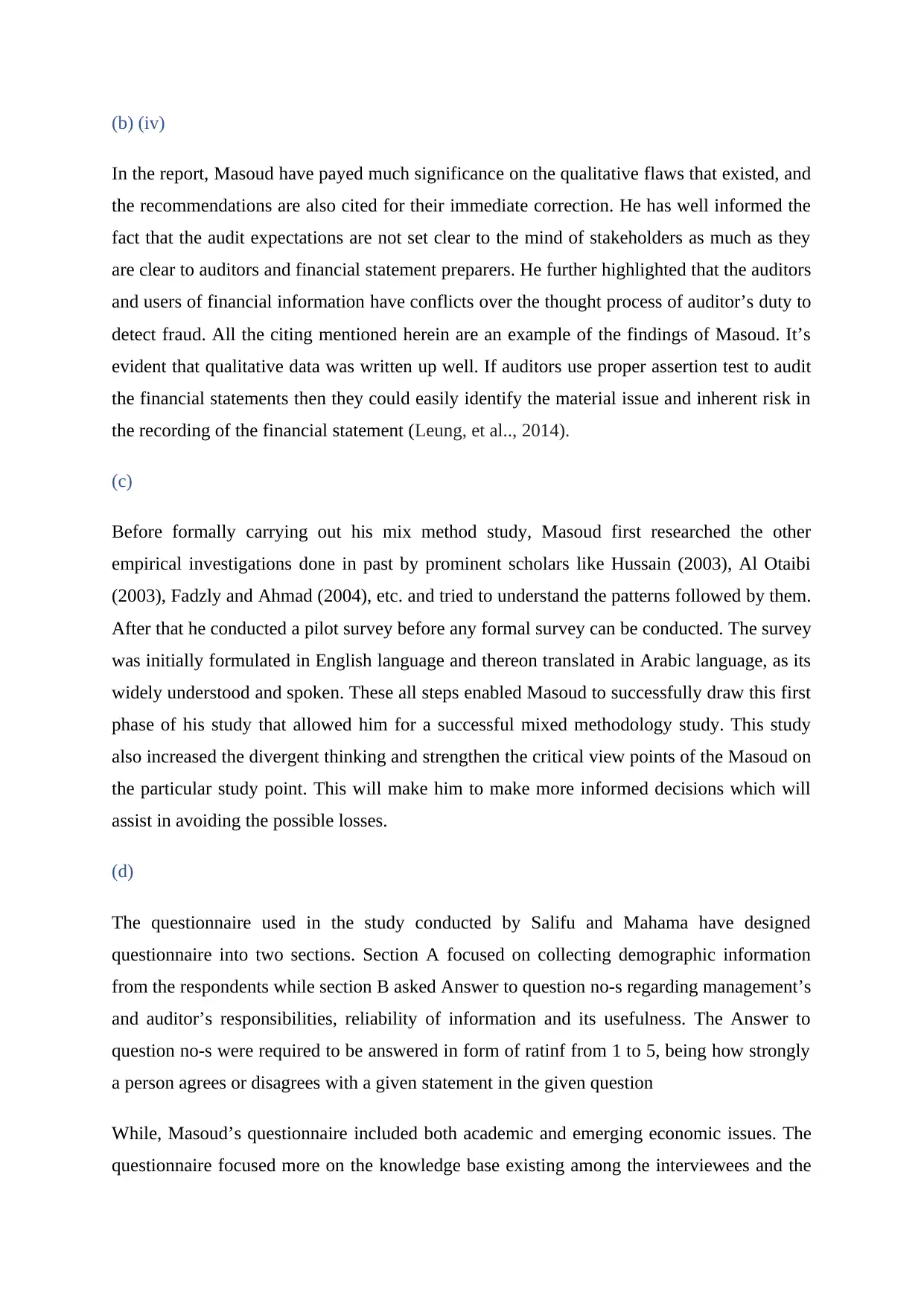
(b) (iv)
In the report, Masoud have payed much significance on the qualitative flaws that existed, and
the recommendations are also cited for their immediate correction. He has well informed the
fact that the audit expectations are not set clear to the mind of stakeholders as much as they
are clear to auditors and financial statement preparers. He further highlighted that the auditors
and users of financial information have conflicts over the thought process of auditor’s duty to
detect fraud. All the citing mentioned herein are an example of the findings of Masoud. It’s
evident that qualitative data was written up well. If auditors use proper assertion test to audit
the financial statements then they could easily identify the material issue and inherent risk in
the recording of the financial statement (Leung, et al.., 2014).
(c)
Before formally carrying out his mix method study, Masoud first researched the other
empirical investigations done in past by prominent scholars like Hussain (2003), Al Otaibi
(2003), Fadzly and Ahmad (2004), etc. and tried to understand the patterns followed by them.
After that he conducted a pilot survey before any formal survey can be conducted. The survey
was initially formulated in English language and thereon translated in Arabic language, as its
widely understood and spoken. These all steps enabled Masoud to successfully draw this first
phase of his study that allowed him for a successful mixed methodology study. This study
also increased the divergent thinking and strengthen the critical view points of the Masoud on
the particular study point. This will make him to make more informed decisions which will
assist in avoiding the possible losses.
(d)
The questionnaire used in the study conducted by Salifu and Mahama have designed
questionnaire into two sections. Section A focused on collecting demographic information
from the respondents while section B asked Answer to question no-s regarding management’s
and auditor’s responsibilities, reliability of information and its usefulness. The Answer to
question no-s were required to be answered in form of ratinf from 1 to 5, being how strongly
a person agrees or disagrees with a given statement in the given question
While, Masoud’s questionnaire included both academic and emerging economic issues. The
questionnaire focused more on the knowledge base existing among the interviewees and the
In the report, Masoud have payed much significance on the qualitative flaws that existed, and
the recommendations are also cited for their immediate correction. He has well informed the
fact that the audit expectations are not set clear to the mind of stakeholders as much as they
are clear to auditors and financial statement preparers. He further highlighted that the auditors
and users of financial information have conflicts over the thought process of auditor’s duty to
detect fraud. All the citing mentioned herein are an example of the findings of Masoud. It’s
evident that qualitative data was written up well. If auditors use proper assertion test to audit
the financial statements then they could easily identify the material issue and inherent risk in
the recording of the financial statement (Leung, et al.., 2014).
(c)
Before formally carrying out his mix method study, Masoud first researched the other
empirical investigations done in past by prominent scholars like Hussain (2003), Al Otaibi
(2003), Fadzly and Ahmad (2004), etc. and tried to understand the patterns followed by them.
After that he conducted a pilot survey before any formal survey can be conducted. The survey
was initially formulated in English language and thereon translated in Arabic language, as its
widely understood and spoken. These all steps enabled Masoud to successfully draw this first
phase of his study that allowed him for a successful mixed methodology study. This study
also increased the divergent thinking and strengthen the critical view points of the Masoud on
the particular study point. This will make him to make more informed decisions which will
assist in avoiding the possible losses.
(d)
The questionnaire used in the study conducted by Salifu and Mahama have designed
questionnaire into two sections. Section A focused on collecting demographic information
from the respondents while section B asked Answer to question no-s regarding management’s
and auditor’s responsibilities, reliability of information and its usefulness. The Answer to
question no-s were required to be answered in form of ratinf from 1 to 5, being how strongly
a person agrees or disagrees with a given statement in the given question
While, Masoud’s questionnaire included both academic and emerging economic issues. The
questionnaire focused more on the knowledge base existing among the interviewees and the
⊘ This is a preview!⊘
Do you want full access?
Subscribe today to unlock all pages.

Trusted by 1+ million students worldwide
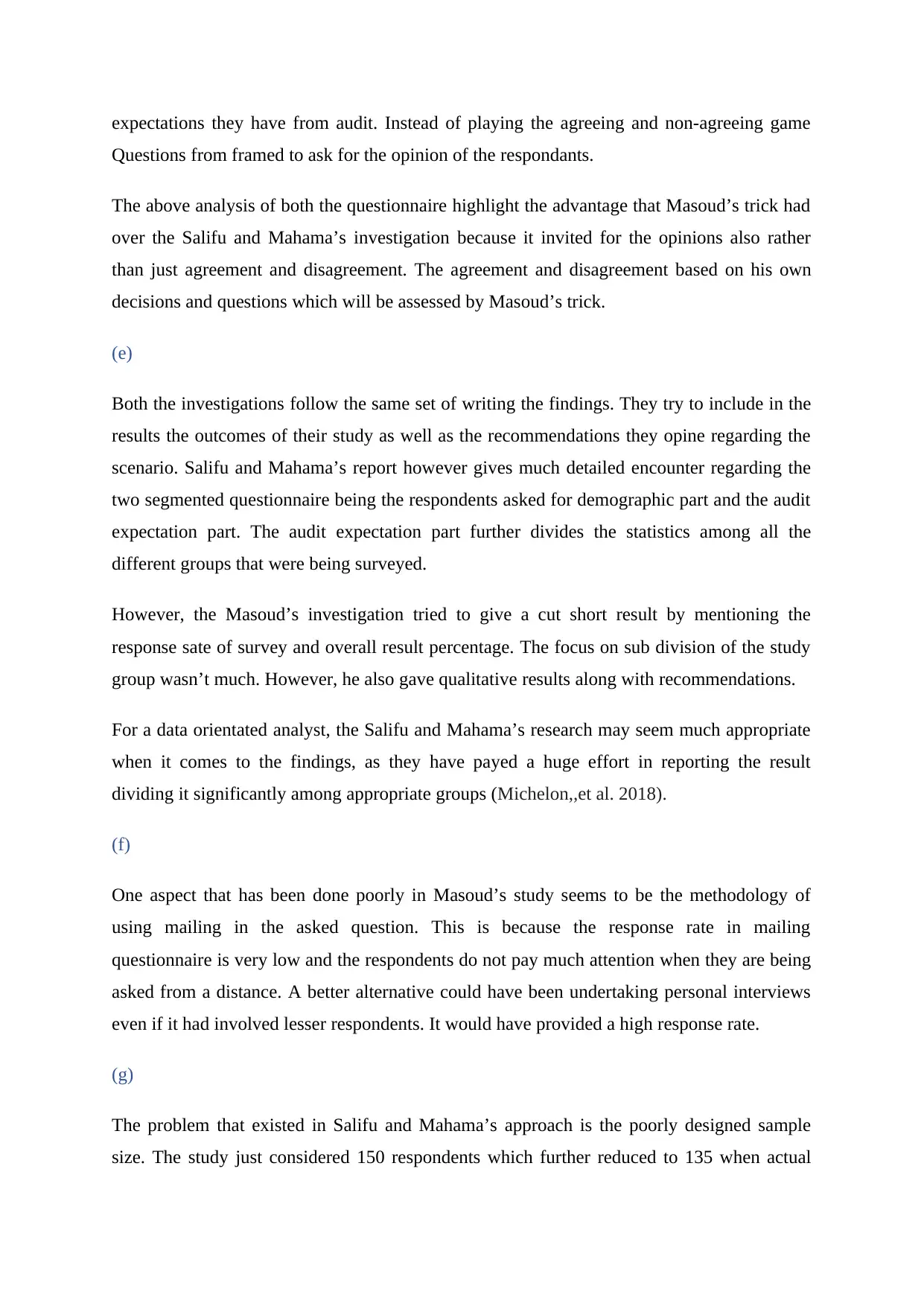
expectations they have from audit. Instead of playing the agreeing and non-agreeing game
Questions from framed to ask for the opinion of the respondants.
The above analysis of both the questionnaire highlight the advantage that Masoud’s trick had
over the Salifu and Mahama’s investigation because it invited for the opinions also rather
than just agreement and disagreement. The agreement and disagreement based on his own
decisions and questions which will be assessed by Masoud’s trick.
(e)
Both the investigations follow the same set of writing the findings. They try to include in the
results the outcomes of their study as well as the recommendations they opine regarding the
scenario. Salifu and Mahama’s report however gives much detailed encounter regarding the
two segmented questionnaire being the respondents asked for demographic part and the audit
expectation part. The audit expectation part further divides the statistics among all the
different groups that were being surveyed.
However, the Masoud’s investigation tried to give a cut short result by mentioning the
response sate of survey and overall result percentage. The focus on sub division of the study
group wasn’t much. However, he also gave qualitative results along with recommendations.
For a data orientated analyst, the Salifu and Mahama’s research may seem much appropriate
when it comes to the findings, as they have payed a huge effort in reporting the result
dividing it significantly among appropriate groups (Michelon,,et al. 2018).
(f)
One aspect that has been done poorly in Masoud’s study seems to be the methodology of
using mailing in the asked question. This is because the response rate in mailing
questionnaire is very low and the respondents do not pay much attention when they are being
asked from a distance. A better alternative could have been undertaking personal interviews
even if it had involved lesser respondents. It would have provided a high response rate.
(g)
The problem that existed in Salifu and Mahama’s approach is the poorly designed sample
size. The study just considered 150 respondents which further reduced to 135 when actual
Questions from framed to ask for the opinion of the respondants.
The above analysis of both the questionnaire highlight the advantage that Masoud’s trick had
over the Salifu and Mahama’s investigation because it invited for the opinions also rather
than just agreement and disagreement. The agreement and disagreement based on his own
decisions and questions which will be assessed by Masoud’s trick.
(e)
Both the investigations follow the same set of writing the findings. They try to include in the
results the outcomes of their study as well as the recommendations they opine regarding the
scenario. Salifu and Mahama’s report however gives much detailed encounter regarding the
two segmented questionnaire being the respondents asked for demographic part and the audit
expectation part. The audit expectation part further divides the statistics among all the
different groups that were being surveyed.
However, the Masoud’s investigation tried to give a cut short result by mentioning the
response sate of survey and overall result percentage. The focus on sub division of the study
group wasn’t much. However, he also gave qualitative results along with recommendations.
For a data orientated analyst, the Salifu and Mahama’s research may seem much appropriate
when it comes to the findings, as they have payed a huge effort in reporting the result
dividing it significantly among appropriate groups (Michelon,,et al. 2018).
(f)
One aspect that has been done poorly in Masoud’s study seems to be the methodology of
using mailing in the asked question. This is because the response rate in mailing
questionnaire is very low and the respondents do not pay much attention when they are being
asked from a distance. A better alternative could have been undertaking personal interviews
even if it had involved lesser respondents. It would have provided a high response rate.
(g)
The problem that existed in Salifu and Mahama’s approach is the poorly designed sample
size. The study just considered 150 respondents which further reduced to 135 when actual
Paraphrase This Document
Need a fresh take? Get an instant paraphrase of this document with our AI Paraphraser
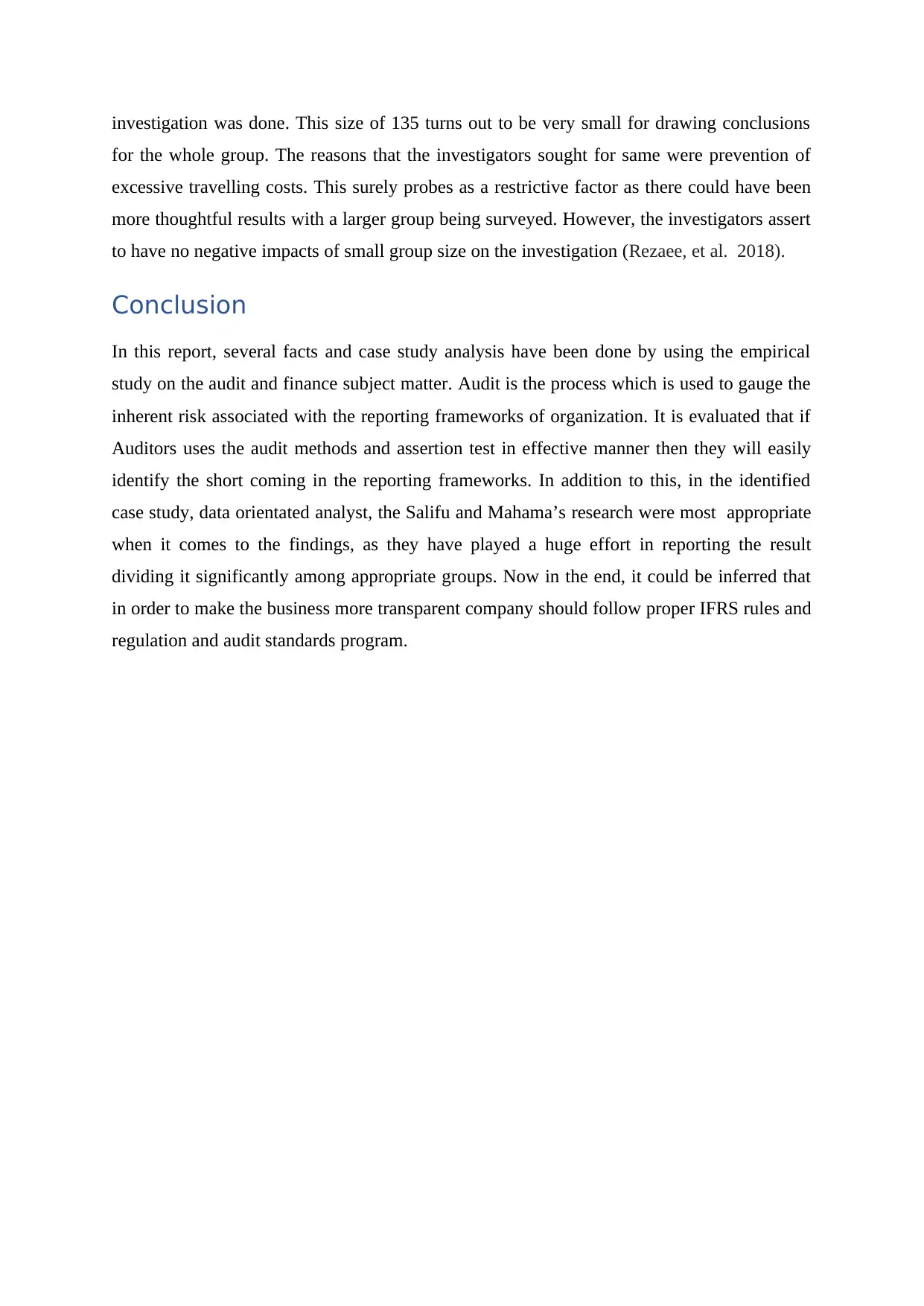
investigation was done. This size of 135 turns out to be very small for drawing conclusions
for the whole group. The reasons that the investigators sought for same were prevention of
excessive travelling costs. This surely probes as a restrictive factor as there could have been
more thoughtful results with a larger group being surveyed. However, the investigators assert
to have no negative impacts of small group size on the investigation (Rezaee, et al. 2018).
Conclusion
In this report, several facts and case study analysis have been done by using the empirical
study on the audit and finance subject matter. Audit is the process which is used to gauge the
inherent risk associated with the reporting frameworks of organization. It is evaluated that if
Auditors uses the audit methods and assertion test in effective manner then they will easily
identify the short coming in the reporting frameworks. In addition to this, in the identified
case study, data orientated analyst, the Salifu and Mahama’s research were most appropriate
when it comes to the findings, as they have played a huge effort in reporting the result
dividing it significantly among appropriate groups. Now in the end, it could be inferred that
in order to make the business more transparent company should follow proper IFRS rules and
regulation and audit standards program.
for the whole group. The reasons that the investigators sought for same were prevention of
excessive travelling costs. This surely probes as a restrictive factor as there could have been
more thoughtful results with a larger group being surveyed. However, the investigators assert
to have no negative impacts of small group size on the investigation (Rezaee, et al. 2018).
Conclusion
In this report, several facts and case study analysis have been done by using the empirical
study on the audit and finance subject matter. Audit is the process which is used to gauge the
inherent risk associated with the reporting frameworks of organization. It is evaluated that if
Auditors uses the audit methods and assertion test in effective manner then they will easily
identify the short coming in the reporting frameworks. In addition to this, in the identified
case study, data orientated analyst, the Salifu and Mahama’s research were most appropriate
when it comes to the findings, as they have played a huge effort in reporting the result
dividing it significantly among appropriate groups. Now in the end, it could be inferred that
in order to make the business more transparent company should follow proper IFRS rules and
regulation and audit standards program.

References
Alles, M. G., Kogan, A., and Vasarhelyi, M. A. 2018. Feasibility and Economics of
Continuous Assurance 1. In Continuous Auditing: Theory and Application (pp. 149-167).
Emerald Publishing Limited.
Arens, A. A., Elder, R. J., and Mark, B. 2012. Auditing and assurance services: an integrated
approach. Boston: Prentice Hall.
Chambers, A.D. and Odar, M., 2015. A new vision for internal audit. Managerial Auditing
Journal, 30(1), pp.34-55.
Chan, D.Y., Chiu, V. and Vasarhelyi, M.A. eds., 2018. Continuous Auditing: Theory and
Application.
Christensen, B. E., Glover, S. M., and Wood, D. A. 2012. Extreme estimation uncertainty in
fair value estimates: Implications for audit assurance. Auditing: A Journal of Practice &
Theory, 31(1), 127-146.
Cohen, J., Krishnamoorthy, G. and Wright, A., 2017. Enterprise risk management and the
financial reporting process: The experiences of audit committee members, CFOs, and
external auditors. Contemporary Accounting Research, 34(2), pp.1178-1209.
Cohen, J.R. and Simnett, R., 2014. CSR and assurance services: A research
agenda. Auditing: A Journal of Practice & Theory, 34(1), pp.59-74.
Edgley, C., Jones, M.J. and Atkins, J., 2015. The adoption of the materiality concept in social
and environmental reporting assurance: A field study approach. The British Accounting
Review, 47(1), pp.1-18.
Hines, C.S., Masli, A., Mauldin, E.G. and Peters, G.F., 2015. Board risk committees and
audit pricing. Auditing: A Journal of Practice & Theory, 34(4), pp.59-84.
Knechel, W.R. and Salterio, S.E., 2016. Auditing: Assurance and risk. Taylor & Francis.
Kogan, A., Sudit, E.F. and Vasarhelyi, M.A., 2018. Continuous online auditing: A program
of research. In Continuous Auditing: Theory and Application (pp. 125-148). Emerald
Publishing Limited.
Leung, P., Coram, P., Cooper, B.J. and Richardson, P., 2014. Modern Auditing and
Assurance Services 6e. Wiley.
Michelon, G., Patten, D.M. and Romi, A.M., 2018. Creating Legitimacy for Sustainability
Assurance Practices: Evidence from Sustainability Restatements. European Accounting
Review, pp.1-28.
Rezaee, Z., Sharbatoghlie, A., Elam, R. and McMickle, P.L., 2018. Continuous auditing:
Building automated auditing capability. In Continuous Auditing: Theory and Application (pp.
169-190). Emerald Publishing Limited.
Alles, M. G., Kogan, A., and Vasarhelyi, M. A. 2018. Feasibility and Economics of
Continuous Assurance 1. In Continuous Auditing: Theory and Application (pp. 149-167).
Emerald Publishing Limited.
Arens, A. A., Elder, R. J., and Mark, B. 2012. Auditing and assurance services: an integrated
approach. Boston: Prentice Hall.
Chambers, A.D. and Odar, M., 2015. A new vision for internal audit. Managerial Auditing
Journal, 30(1), pp.34-55.
Chan, D.Y., Chiu, V. and Vasarhelyi, M.A. eds., 2018. Continuous Auditing: Theory and
Application.
Christensen, B. E., Glover, S. M., and Wood, D. A. 2012. Extreme estimation uncertainty in
fair value estimates: Implications for audit assurance. Auditing: A Journal of Practice &
Theory, 31(1), 127-146.
Cohen, J., Krishnamoorthy, G. and Wright, A., 2017. Enterprise risk management and the
financial reporting process: The experiences of audit committee members, CFOs, and
external auditors. Contemporary Accounting Research, 34(2), pp.1178-1209.
Cohen, J.R. and Simnett, R., 2014. CSR and assurance services: A research
agenda. Auditing: A Journal of Practice & Theory, 34(1), pp.59-74.
Edgley, C., Jones, M.J. and Atkins, J., 2015. The adoption of the materiality concept in social
and environmental reporting assurance: A field study approach. The British Accounting
Review, 47(1), pp.1-18.
Hines, C.S., Masli, A., Mauldin, E.G. and Peters, G.F., 2015. Board risk committees and
audit pricing. Auditing: A Journal of Practice & Theory, 34(4), pp.59-84.
Knechel, W.R. and Salterio, S.E., 2016. Auditing: Assurance and risk. Taylor & Francis.
Kogan, A., Sudit, E.F. and Vasarhelyi, M.A., 2018. Continuous online auditing: A program
of research. In Continuous Auditing: Theory and Application (pp. 125-148). Emerald
Publishing Limited.
Leung, P., Coram, P., Cooper, B.J. and Richardson, P., 2014. Modern Auditing and
Assurance Services 6e. Wiley.
Michelon, G., Patten, D.M. and Romi, A.M., 2018. Creating Legitimacy for Sustainability
Assurance Practices: Evidence from Sustainability Restatements. European Accounting
Review, pp.1-28.
Rezaee, Z., Sharbatoghlie, A., Elam, R. and McMickle, P.L., 2018. Continuous auditing:
Building automated auditing capability. In Continuous Auditing: Theory and Application (pp.
169-190). Emerald Publishing Limited.
⊘ This is a preview!⊘
Do you want full access?
Subscribe today to unlock all pages.

Trusted by 1+ million students worldwide
1 out of 13
Related Documents
Your All-in-One AI-Powered Toolkit for Academic Success.
+13062052269
info@desklib.com
Available 24*7 on WhatsApp / Email
![[object Object]](/_next/static/media/star-bottom.7253800d.svg)
Unlock your academic potential
Copyright © 2020–2025 A2Z Services. All Rights Reserved. Developed and managed by ZUCOL.




